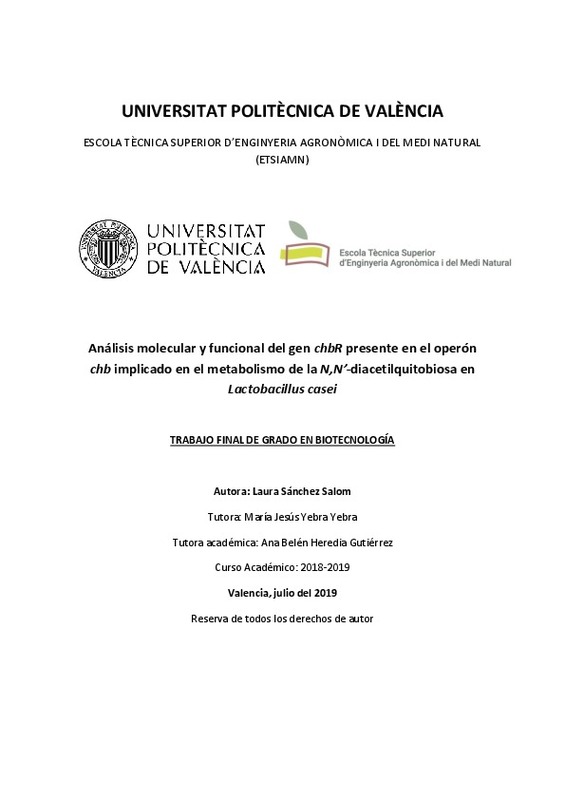|
Resumen:
|
[ES] La leche humana es un fluido biológico complejo que contiene glicanos bien como
oligosacáridos libres (OLH) o bien formando parte de glicoproteínas y glicolípidos. Todos ellos
atraviesan el tracto gastrointestinal ...[+]
[ES] La leche humana es un fluido biológico complejo que contiene glicanos bien como
oligosacáridos libres (OLH) o bien formando parte de glicoproteínas y glicolípidos. Todos ellos
atraviesan el tracto gastrointestinal y llegan intactos al colon, donde son utilizados por
bacterias beneficiosas para la salud del bebé. Entre estas bacterias, es de especial relevancia el
género Lactobacillus, que se encuentra comúnmente en el tracto gastrointestinal de los
lactantes e incluye varias cepas con propiedades probióticas.
La N,N’-diacetilquitobiosa (ChbNAc) es un disacárido que forma parte del núcleo de la Nglicosilación de las glicoproteínas presentes en la leche humana y en la mucosa intestinal. Ha
sido demostrado con anterioridad que la ChbNAc es utilizada como fuente de carbono por
Lactobacillus casei cepa BL23 y que el operón chb está implicado en su metabolismo. Los genes
chbRCDE codifican para un hipotético regulador transcripcional, un dominio IIC del sistema de
transporte de la fosfotransferasa dependiente de fosfoenolpiruvato (PTS) y dos proteínas
hipotéticas D y E, respectivamente, mientras que el cluster de genes chbBAF codifica para los
dominios IIB y IIA del PTS, y para una hipotética N-acetiltransferasa.
En este trabajo se ha construido un vector para inactivar el gen chbR y se ha obtenido una
cepa mutante de L. casei BL23 deficiente en este gen. Se ha observado que este mutante es
capaz de utilizar tanto la ChbNAc como el trisacárido N,N’,N’’-diacetilquitotriosa como fuentes
de carbono en el medio de cultivo, sugiriendo que el regulador ChbR es un represor
transcripcional.
[-]
[EN] Human milk is a complex biological fluid that contains glycans such as free human milk
oligosaccharides (HMO) or forming part of glycoproteins and glycolipids. All of them transit
through the gastrointestinal tract ...[+]
[EN] Human milk is a complex biological fluid that contains glycans such as free human milk
oligosaccharides (HMO) or forming part of glycoproteins and glycolipids. All of them transit
through the gastrointestinal tract and arrive intact to the colon where they are used by
beneficial bacteria in order to improve babys’ health. Among these bacteria, especial relevance
is according to Lactobacillus genus, which is commonly found at the gastrointestinal tract of
infants and includes various strains with probiotic properties.
The N,N'-diacetylchitobiose (ChbNAc) is a disaccharide forming part of the N-glycosylation core
of the glycoproteins present in human milk and intestinal mucosae. It has been previously
shown that the ChbNAc is used as a carbon source by Lactobacillus casei BL23 strain and that
the chb operon is involved in its metabolism. The chbRCDE genes encode a hypothetical
transcriptional regulator, a IIC domain of the phosphotransferase system (PTS) and two
hypothetical proteins, D and E, respectively, whereas the chbBAF gene cluster encodes IIB and
IIA PTS domains, and a hypothetical N-acetyltransferase.
In this work, a vector has been constructed to inactivate the chbR gene and a mutant strain of
L. casei BL23 deficient in this gene has been obtained. It has been observed that this mutant is
able to use both ChbNAc and the trisaccharide N,N’,N’’-diacetylchitotriose as carbon sources in
the culture medium, suggesting that the chbR regulator is a transcriptional repressor.
[-]
|







